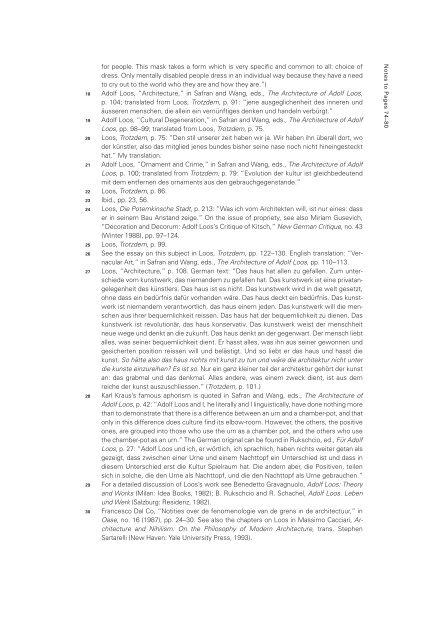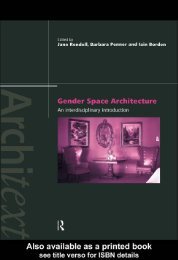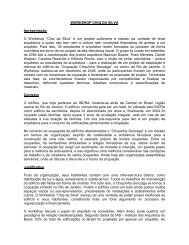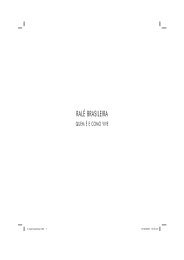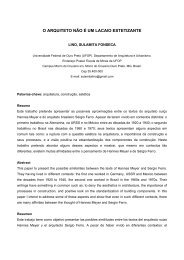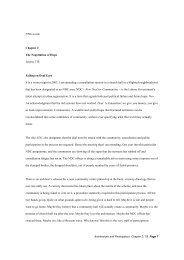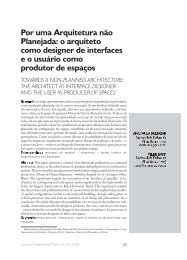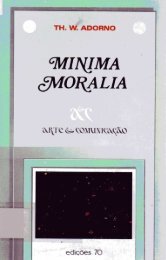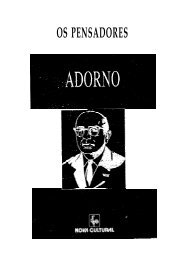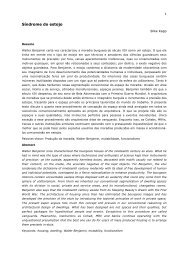Architecture and Modernity : A Critique
Architecture and Modernity : A Critique
Architecture and Modernity : A Critique
You also want an ePaper? Increase the reach of your titles
YUMPU automatically turns print PDFs into web optimized ePapers that Google loves.
for people. This mask takes a form which is very specific <strong>and</strong> common to all: choice of<br />
dress. Only mentally disabled people dress in an individual way because they have a need<br />
to cry out to the world who they are <strong>and</strong> how they are.”)<br />
18 Adolf Loos, “<strong>Architecture</strong>,” in Safran <strong>and</strong> Wang, eds., The <strong>Architecture</strong> of Adolf Loos,<br />
p. 104; translated from Loos, Trotzdem, p. 91: “jene ausgeglichenheit des inneren und<br />
äusseren menschen, die allein ein vernünftiges denken und h<strong>and</strong>eln verbürgt.”<br />
19 Adolf Loos, “Cultural Degeneration,” in Safran <strong>and</strong> Wang, eds., The <strong>Architecture</strong> of Adolf<br />
Loos, pp. 98–99; translated from Loos, Trotzdem, p. 75.<br />
20 Loos, Trotzdem, p. 75: “Den stil unserer zeit haben wir ja. Wir haben ihn überall dort, wo<br />
der künstler, also das mitglied jenes bundes bisher seine nase noch nicht hineingesteckt<br />
hat.” My translation.<br />
21 Adolf Loos, “Ornament <strong>and</strong> Crime,” in Safran <strong>and</strong> Wang, eds., The <strong>Architecture</strong> of Adolf<br />
Loos, p. 100; translated from Trotzdem, p. 79: “Evolution der kultur ist gleichbedeutend<br />
mit dem entfernen des ornaments aus den gebrauchgegenst<strong>and</strong>e.”<br />
22 Loos, Trotzdem, p. 86.<br />
23 Ibid., pp. 23, 56.<br />
24 Loos, Die Potemkinsche Stadt, p. 213: “Was ich vom Architekten will, ist nur eines: dass<br />
er in seinem Bau Anst<strong>and</strong> zeige.” On the issue of propriety, see also Miriam Gusevich,<br />
“Decoration <strong>and</strong> Decorum: Adolf Loos’s <strong>Critique</strong> of Kitsch,” New German <strong>Critique</strong>, no. 43<br />
(Winter 1988), pp. 97–124.<br />
25 Loos, Trotzdem, p. 99.<br />
26 See the essay on this subject in Loos, Trotzdem, pp. 122–130. English translation: “Vernacular<br />
Art,” in Safran <strong>and</strong> Wang, eds., The <strong>Architecture</strong> of Adolf Loos, pp. 110–113.<br />
27 Loos, “<strong>Architecture</strong>,” p. 108. German text: “Das haus hat allen zu gefallen. Zum unterschiede<br />
vom kunstwerk, das niem<strong>and</strong>em zu gefallen hat. Das kunstwerk ist eine privatangelegenheit<br />
des künstlers. Das haus ist es nicht. Das kunstwerk wird in die welt gesetzt,<br />
ohne dass ein bedürfnis dafür vorh<strong>and</strong>en wäre. Das haus deckt ein bedürfnis. Das kunstwerk<br />
ist niem<strong>and</strong>em verantwortlich, das haus einem jeden. Das kunstwerk will die menschen<br />
aus ihrer bequemlichkeit reissen. Das haus hat der bequemlichkeit zu dienen. Das<br />
kunstwerk ist revolutionär, das haus konservativ. Das kunstwerk weist der menschheit<br />
neue wege und denkt an die zukunft. Das haus denkt an der gegenwart. Der mensch liebt<br />
alles, was seiner bequemlichkeit dient. Er hasst alles, was ihn aus seiner gewonnen und<br />
gesicherten position reissen will und belästigt. Und so liebt er das haus und hasst die<br />
kunst. So hätte also das haus nichts mit kunst zu tun und wäre die architektur nicht unter<br />
die kunste einzureihen? Es ist so. Nur ein ganz kleiner teil der architektur gehört der kunst<br />
an: das grabmal und das denkmal. Alles <strong>and</strong>ere, was einem zweck dient, ist aus dem<br />
reiche der kunst auszuschliessen.” (Trotzdem, p. 101.)<br />
28 Karl Kraus’s famous aphorism is quoted in Safran <strong>and</strong> Wang, eds., The <strong>Architecture</strong> of<br />
Adolf Loos, p. 42: “Adolf Loos <strong>and</strong> I, he literally <strong>and</strong> I linguistically, have done nothing more<br />
than to demonstrate that there is a difference between an urn <strong>and</strong> a chamber-pot, <strong>and</strong> that<br />
only in this difference does culture find its elbow-room. However, the others, the positive<br />
ones, are grouped into those who use the urn as a chamber pot, <strong>and</strong> the others who use<br />
the chamber-pot as an urn.” The German original can be found in Rukschcio, ed., Für Adolf<br />
Loos, p. 27: “Adolf Loos und ich, er wörtlich, ich sprachlich, haben nichts weiter getan als<br />
gezeigt, dass zwischen einer Urne und einem Nachttopf ein Unterschied ist und dass in<br />
diesem Unterschied erst die Kultur Spielraum hat. Die <strong>and</strong>ern aber, die Positiven, teilen<br />
sich in solche, die den Urne als Nachttopf, und die den Nachttopf als Urne gebrauchen.”<br />
29 For a detailed discussion of Loos’s work see Benedetto Gravagnuolo, Adolf Loos: Theory<br />
<strong>and</strong> Works (Milan: Idea Books, 1982); B. Rukschcio <strong>and</strong> R. Schachel, Adolf Loos. Leben<br />
und Werk (Salzburg: Residenz, 1982).<br />
30 Francesco Dal Co, “Notities over de fenomenologie van de grens in de architectuur,” in<br />
Oase, no. 16 (1987), pp. 24–30. See also the chapters on Loos in Massimo Cacciari, <strong>Architecture</strong><br />
<strong>and</strong> Nihilism: On the Philosophy of Modern <strong>Architecture</strong>, trans. Stephen<br />
Sartarelli (New Haven: Yale University Press, 1993).<br />
Notes to Pages 74–80


